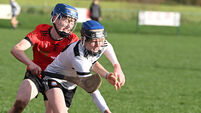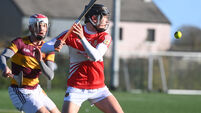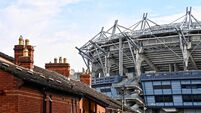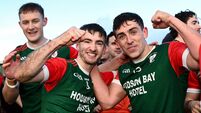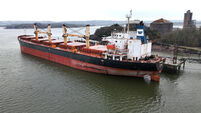Enda McEvoy: Off-Broadway, Laois and Antrim bid for spotlight and ovations

Laois manager Seamus Plunkett talks to his team. Picture: INPHO/Brian Reilly-Troy
Were it not for John Leahy and his haul of 1-4, one of the papers declared next day, Laois would have beaten Tipperary in the 1996 National League semi-final at Nowlan Park instead of losing by two points (1-13 to 1-11).
It was that close. Laois were that good.
Under Babs Keating they’d topped a Division 2 that contained Wexford and Limerick, the All-Ireland finalists in waiting. They’d seen off Kilkenny in the quarter-final. They had Niall Rigney and Joe Dollard and several Cuddys, among them the great PJ Cuddy. Still wearing the number 14 jersey, still piratically bearded, still trucking.
All of the above is to make the point to younger readers that there was a time, even if to them it may sound like several centuries ago, when both Laois and Antrim were respected and reliable members of hurling’s aspirant middle class, a level — but only a level — below the elite.
They were hardy, they were competent, they possessed plenty of good hurlers (except never enough of them) and though they weren’t going to be lifting any MacCarthy Cups you never took them for granted, particularly during the league.
For obvious reasons of population and demographics Laois were permanently punching above their weight, a plight compounded by the move from three subs to five subs 20 years ago, an innovation that further weighted the odds in favour of the big guns. Yet the devotion to the game in the county remains undimmed. Any time a Laois hurling topic comes up on social media it’s instructive to see just how many people get stuck in and just how vigorously they do so.
Laois and Antrim take to the boards on Saturday and if the bill of fare is nothing more exotic than provincial quarter-final action they’re not complaining about that. In any case the Leinster quarter-final stage is precisely that. A stage. However far off-Broadway its coordinates is irrelevant. Both counties endured enough summers when the lift started in the lobby but didn’t go up as far as the MacCarthy Cup floors.
Laois’s task, against Wexford, in a repeat of their National League opener, is the stiffer one. Extenuating circumstances abounded on foot of their 4-17 to 0-10 defeat in Wexford Park. They were back training only three weeks, they had a rake of injuries, they drove 21 wides, they conceded two goals after the 70th minute and in any case Seamus Plunkett’s defensive system was always going to require time and buy-in.
All told, the final score looked worse than the performance — and in the matches that followed they registered tallies of 1-19, 1-17, 0-22 and 1-22. A discernible improvement, albeit this particular line on the graph will not keep rising indefinitely. Rather more disquieting is the fact that the injury situation hasn’t cleared up; Plunkett has too many walking wounded and absentees in a scenario where he cannot afford any walking wounded or absentees.
If everyone knew the qualities Plunkett would bring to Laois on his second coming, few could have anticipated the difference Darren Gleeson has made in Antrim. Off the field he has a compendious and well-funded backroom team; on it he has a team that, refreshingly, try to score goals. Gerard Walsh is making a success of his switch from wing-back to full-back and Neil McManus’s half-forward line is one at least half of the other counties in Division One would love to call their own.
The formbook says Antrim are up against it versus Dublin, who beat them by eight points in Parnell Park last month and who’ll be buoyed, however tangentially, by their provincial under-20 triumph last Wednesday. Even without having witnessed it you’ll be able to venture how that league game went. Dublin were too big and strong and closed their visitors down.
That doesn’t tell quite the whole story. If Dublin were bigger and stronger, resistance was less than it might have been. And that is very easily explained because Antrim had poured everything of themselves into the games with Clare and Kilkenny over the previous two weekends.
They were physically tired and mentally exhausted, with Gleeson speaking afterwards about the need for them to come to terms with the demands and realities of an 80-minute game. We’ll discover Saturday how much closer they’ve got.
Antrim have demonstrated they can score goals; Dublin aren’t all that interested in green flags and are less likely to generate them after the injury to Eamon Dillon. Dillon is a blast of fresh and uncomplicated air, a throwback in an age where inside forwards are hardwired to drift away from the opposition posts and do their work from the wings. This guy, incredibly, heads straight for goal. He can be a blunt instrument but he occupies defenders and opens up great swathes of space and Dublin will miss his incisiveness.
Semple Stadium on Sunday? Clare appear to have turned the corner, thank heavens. Sometimes one win is all it takes, regardless of how unconvincing, but there was nothing unconvincing about their four-goal salvo against Kilkenny. Brian Lohan no longer looked like a man bearing the weight of the world on his shoulders.
This has to be classed as a winnable fixture for them despite the return of Austin Gleeson and Shane Fives to fitness for their opponents. But here’s a subversive thought: would it really be the end of the world for Waterford were they to lose? Defeat, understandable in the circumstances, would represent a setback, but nothing more than that and certainly not the undoing of all last year’s good work. A straight four-match run to an All-Ireland final may be a challenge beyond Waterford’s resources. A trip via the backroad that leaves them bouncing off the ground come a quarter-final is not.

Unlimited access. Half the price.
Try unlimited access from only €1.50 a week
Already a subscriber? Sign in

